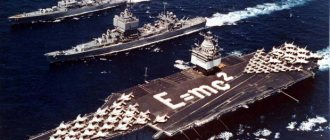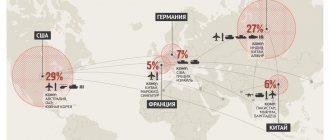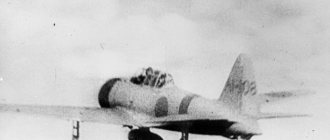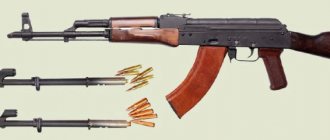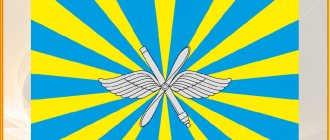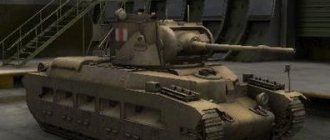Academician
04/13/2012, 10:19, , 417, Category Equipment
Top 10 heavy tanks in the world
Military tanks
, is an impressive sight. The tank was conceived as the main weapon against infantry.
Below, the TOP 10 largest tanks by weight and size in the world. Almost all super heavy tanks were built or developed during World War II.
Above, photos of the actually created gun, which was supposed to be installed on the Monster tank
Landkreuzer P. 1500 Monster
Germany, 1942, 42 meters, weight 1500 tons, crew 100 people
In 1942, Hitler approved the design and construction of the monster tank, but the project was canceled in 1943 before construction had even begun. The tank was supposed to be fifteen times larger than a regular tank, it was supposed to be equipped with an 800 mm Krupp gun (regular tanks are equipped with 75 - 122 mm guns).
The 800 mm Krupp gun is the largest artillery piece ever built. Each shell weighed 7 tons and had a firing range of up to 37 km (23 mi).
Landkreuzer P. 1000 Ratte
Landkreuzer P. 1000 Ratte
Germaniz, 1942, 35 meters, weight 1000 tons, crew 20 people
Ratte looked a lot like a monster. It was also developed in 1942 and was also discontinued a year later. Unlike the Monster, the Ratte was to be armed with a warship turret with two 280mm cannons. Other weapons on the Ratte include one 128 mm cannon, eight 20 mm anti-aircraft guns and several 15 mm machine guns.
VIII Mouse
Tank VIII Maus is the largest tank ever built. It is small compared to the Monster and Ratte, but is still three times larger than a regular tank. Design was completed in 1942 and production began the same year, but only two tanks were built before the end of the war.
The tanks were armed with one 128 mm gun and one 75 mm gun.
Tank VIII Mouse
Germany, 1944 - 10 meters, weight 188 tons, crew 6
E-100 Tiger Mouse
The super heavy tank is very similar to the VIII Mouse tank. This project was started in 1942, but not all tanks were built. One tank hull was built in 1944, but the turret was not installed until after the war.
The E-100 Tiger Mouse was to use the same turrets as the VIII Mouse tank. Thanks to its lighter weight, this tank should be faster and more effective on the battlefield than the VIII Mouse tank.
E-100 Tiger Mouse
Germany, 1943 - 10 meters, weight 140 tons, crew 5 people
FCM F1
FCM F1 is the heaviest and largest tank of non-Nazi origin. It was intended to replace the Char 2C, which was one of the heaviest tanks that had never been used in combat. Unfortunately, France was defeated before the FCM F1 project was completed, so none of these tanks were built.
The FCM F1 was supposed to be armed with a 90 mm cannon, a 47 mm cannon, and six machine guns. It's worth noting that this tank was 10 meters long, but only just over 3 meters wide, so it could have been transported by rail.
FCM F1
France, 1940, 11 meters, weight 139 tons, crew 9 people
OI
OI, this is Japan's attempt to create a super heavy tank. There are reports from various sources that one model was completed and sent to Manchuria during World War II, but this is highly unlikely and is more likely to be rumor than truth. OI was probably canceled like most other super heavy tank projects.
OI was to have three turrets. The main turret had a 105 mm cannon, the right turret had a 37 mm cannon, and the left turret had three machine guns.
OI
Japan, 1944, 10 meters, weight 130 tons, crew 11 people
K-Wagen
The K-Wagen was one of the first attempts to create a super-heavy tank. Again, it was a crazy plan by engineers from Germany, but this time it was before the Nazi era.
The K-Wagen did not have a main turret. Instead there were four side-mounted 77 mm guns and seven machine guns. It is the second largest tank ever actually built - only the VII Maus tank is larger, as all other super-heavy tank projects were not completed.
K-Wagen
Germany, 1917, 13 meters, weight 120 tons, crew 27 people
T-28
The T-28 was developed by the American military during World War II. It was to be used to break through German defenses and a possible invasion of Japan.
The T-28 did not have a normal turret, so it could be classified as a tank destroyer, self-propelled gun, and not a super heavy tank. For this reason, it was renamed from T-28 to T-95, and then back again.
It was armed with one 105 mm cannon and a single machine gun. It had 4 tracks instead of the traditional 2.
T-28
USA, 1945, 11 meters, weight 95 tons, crew 8 people
TOG2
TOG2 was the largest British tank ever built. Just like most other super-heavy tanks, it was developed during World War II. One prototype was built in 1941, but the project was shelved and TOG2 never saw combat.
TOG2 was armed with one 76 mm cannon.
TOG2
Great Britain, 1940, 10 meters, weight 80 tons, crew 8 people
A39 turtle
Another British super heavy tank. The tank was also developed during World War II, but was never put into production.
The A39 Turtle was armed with a 96 mm cannon and three machine guns.
A39 Turtle
Great Britain, 1944 - 10 meters, weight 78 tons, crew 7 people
Why did the army abandon heavy tanks?
Interestingly, almost all of the tanks in the top 10 were built during World War II. What made engineers try to build such monsters at this time, and why weren't such tanks built until now?
The main reason for creating a super-heavy tank was immunity from enemy fire. The super heavy tank had thick armor that would have been impenetrable to most WWII guns.
There are several reasons for abandoning these tanks:
— cumulative shells appeared. Which could penetrate armor up to 500 mm or even more;
- the tank could be hit with the help of aircraft;
— poor maneuverability of the tank during advance and retreat, which limited its use on the battlefield.
Another problem was the transportation of super-heavy tanks. Most were too large to be transported by rail, so they had to rely only on their own propulsion abilities. The problem is that most of them moved extremely slowly, so they could not reach the battlefield at the right time.
In addition, super-heavy tanks destroy roads. Therefore, they would have to drive over rough terrain, which would further slow down the movement.
Heavy tank IS-2 (video):
Heavy tank Grote R-1000 (video):
Heavy tanks IS-3, IS-7 (video):
Similar articles:
Pre-tank era
The design of the first prototype of the tank was proposed in 1874 by the French designer Edouard Bouillen. He came up with the idea of an all-terrain train that would move due to the railway built into it. The military model consisted of 8 sections with 12 guns on the hull. Unfortunately, at that time it was not possible to implement such a project.
Another project was put forward by engineer V.D. Mendeleev in 1916. He designed a model of an armored vehicle with a large-caliber cannon and a machine gun. The project turned out to be difficult to produce and did not interest the Russian government.
Tsar Cannon in Moscow
Contrary to historical speculation, this one of the largest cannons in the world, which is displayed today on the territory of the Moscow Kremlin, has never fired. And obviously there was no way the ashes of False Dmitry could have been shot out of it. Because there is not even a pilot hole in the barrel. Obviously, they never had time to drill it.
And, nevertheless, this is a completely military weapon, cast from bronze in 1586 and, perhaps, one of the oldest examples of large-caliber weapons in the history of the armies of the world
! The only time he was brought into combat position was only in 1591, when the hordes of the Crimean Khan Kazy-Girey approached Moscow (although it is not clear how they could fire the shot).
By the way, the carriage on which the gun is mounted (its caliber is 890 mm and its weight is more than 39 tons) and the cannonballs lying nearby are already cast in 1859. Moreover, the Moscow Tsar Cannon cannot fire exposed cannonballs - this weapon was designed to fire shot and stone cannonballs. But what is the weight of the charge! From 750 kilograms to a ton!
The era of tank vehicles
The development of the world's first tank followed immediately after Mendeleev's project and became famous for its formidable name throughout the world, however, the project was never implemented.
"Tsar Tank"
The car is known to everyone who is interested in tanks. It was designed by engineer Nikolai Lebedenko. On January 8, 1915, the model in drawings was presented to Nicholas II. The Russian emperor was impressed by the engineer’s development and allocated funds for the project. The tank was nicknamed “Bat”, but it turned out to be unsuitable for war: the wheels quickly failed, the tank got stuck on the road.
The Bat is the largest and longest tank in the world. Because of its size, it became famous:
- Weight – 60 t;
- Height – 9 m;
- Length – 17.8 m;
- Width – 12 m.
The impossibility of practical use of the Tsar Tank predetermined its fate - it stood at the assembly site until the model was disposed of in the 1920s.
Char 2C (FCM 2C)
The model is the only representative of the type of super-heavy vehicles put into mass production. The tank was created at the end of the First World War. The purpose of the huge machine was to break through German defensive fortifications. The manufacturer, the French company FCM, received an order to produce 300 copies in February 1918.
While the Char 2C was in production, the warring countries agreed to a truce. Making the Char 2C was expensive and took a lot of time. By 1923, only 10 copies were published. Due to lack of funds, the government decided to discontinue the Char 2C. The tank is designed for 13 crew members. He carried a cannon and 4 machine guns. The Char 2C also had high fuel consumption.
During World War II, one copy of the tank was captured by the Germans, after which nothing is known about it.
K-Wagen
During the First World War, the warring states were interested in creating machines capable of breaking through enemy fortifications. Germany was no exception. In 1917, engineer Josef Vollmer was ordered to develop a German tank with such capabilities. Volmer provided a design for a vehicle weighing 150 tons and 12.8 m long. The military vehicle was driven by two 650 horsepower engines. The weapons included 4 77 mm cannons and 7 machine guns.
The K-Wagen was driven by a crew of 22 people. The designers managed to assemble one model and some components for the second. Due to the approach of Entente troops, the developments had to be destroyed.
FCM F1
By the 1930s The Char 2C (FCM 2C) has ceased to meet the requirements of modern warfare. The French, guided by the experience of the First World War, decided that they needed a new heavy tank.
In 1938, the French military decided on a vision for model number 2. According to their plan, the tank was to have a powerful cannon and a rapid-fire gun. The armor was planned to be made invulnerable to anti-tank guns. The competition for the production of the model was won by FCM. They decided to release the first car by May 1940, but the successes of the German troops prevented these plans.
TOG II
The tank was built by British developers. The model weighing 64 tons reached a speed of no more than 8 km/h. For a number of reasons, TOG II did not go into mass production.
TOG I
The vehicle was developed simultaneously with TOG II. The first TOG I model was released in 1940. The main advantage of the tank was increased maneuverability with a weight of 82.3 tons. Due to the low speed and outdated design, the military abandoned mass production of the model.
Pz.Kpfw VIII Maus
The largest heavy tank in the world is also known as "Mouse". The Mouse was made by the Austrian designer Ferdinand Porsche. Despite the enormous weight of 188 tons, the model has good handling and increased cross-country ability.
By the second half of 1944, two “Mice” were manufactured, but further production stopped due to a lack of funds in Germany.
During the Soviet offensive, tank models were captured. One of them is currently on display in the Kubinka Central Museum. Photos and videos about Mouse are posted on the Internet.
A39 Tortoise
In 1943, British engineers began developing a heavy tank. As planned by the designers, it was supposed to be equipped with powerful armor and combat systems. Therefore, the model began to be called Tortoise - “land turtle”.
In 1944, the manufacturer received an order for the production of 25 cars, but in May 1945, World War II ended, and the need for the “turtle” disappeared. As a result, 5 models were released.
In essence, the “land turtle” was a self-propelled artillery unit, not a tank, but due to its weight of 89 tons, it was classified as a tank. Among the weapons, the “land turtle” had a 94-mm cannon and 3 machine guns. The model was discontinued when it turned out that the tank was inferior to Soviet heavy vehicles in terms of technical characteristics.
Pz.Kpfw. E-100
The developer, Heinrich Ernst Kniepkamp, considered the E-100 as a universal combat vehicle. The armored tank was supposed to displace the "Mouse" and other tracked vehicles. In terms of armor strength, the E-100 was not inferior to the “Mouse”, but had less weight (140 tons).
The project was not completed. The developers only managed to produce the chassis, which later fell into the hands of the British military.
T28-T95 (Turtle)
During World War II, the need for heavy tanks was also felt in the United States. The Americans were preparing to break through the German defense lines, which was quite difficult. This is how the T28-T95 appeared. The project took a long time to be finalized and the tank was ready only in March 1945, but in the same year it was no longer used. Armament included a 105 mm cannon.
"Object 279"
In the 20th century, USSR enterprises produced the largest number of tanks in the world. The government paid attention to the production of medium and light vehicles, but there were not enough resources for super-heavy ones. Before the start of the Great Patriotic War, they were working on creating a copy of a heavy tank at the Kirov plant, but the offensive of German troops forced them to curtail the research.
When World War II ended, the production of heavy tanks was considered unprofitable. The designers focused on inventing machines capable of fighting in a nuclear war. In 1957, the design bureau of Zh. Ya. Kotin released a model of a special tank. The size of the turret armor was 305 mm and the tank weighed 60 tons, but due to poor maneuverability the project did not pass testing.
Due to the thickness of the armor, the appearance of the low vehicle resembled a flying saucer, which is why the specimen was named "Object 279".
The largest fighter
Since the First World War, the appearance of a fighter aircraft has developed, which should be small, maneuverable and fast. All these qualities made fighters the kings of the skies. Many countries often deviated from generally accepted canons, but only in the USSR at the end of the 50s of the last century they developed an interceptor fighter that violated almost all generally accepted canons. And in size it could compete with bombers.
We are talking about the Tu-128, which entered service with air defense units in 1965. In fact, the Tupolev Design Bureau has always specialized in creating either bombers or passenger aircraft, while fighters were built by the Yakovlev, Lavochkin, Mikoyan and Sukhoi Design Bureaus. However, the military liked the project of the Tu-24 front-line bomber, which, according to their recommendations, was soon converted into the Tu-128 fighter.
The two-seat interceptor weighed 43.7 tons, had a top speed of 1,900 km/h and was armed with only four air-to-air missiles. The length of the Tu-128 was 30 meters, the wingspan was 17 meters. For comparison, the Su-15 interceptor was eight meters shorter and had a wingspan of 9.3 meters. The Tu-128 did not have any special advantages, but there were more than enough disadvantages. It could not withstand large overloads, therefore, it was not suitable for air combat, its operation was comparable in cost to the operation of bombers, the low maximum speed did not allow it to catch up and intercept a high-speed target, in addition, much more advanced interceptors appeared very quickly, for example, the same Su-15 and MiG-25. Therefore, only 188 Tu-128s were produced and, as their service life expired, they were written off without much regret, replaced by more modern interceptors. Over the years of service, the Tu-128, unlike the Su-15 and MiG-25, did not participate in interceptions, much less in combat operations, but went down in history as the largest interceptor fighter in the world.
Unrealized projects
Ratte
The development belongs to the German engineer Edward Grotte. According to the plan, the weight of the vehicle was supposed to be 1000 tons. At the same time, the tank would accelerate to 35 km/h. In 1942, the drawings were presented to Hitler and he gave the go-ahead for the construction of the machine. Work on the project was stopped after a year - there were not enough materials to implement it.
TG-5
The project was developed in the early 1930s. at KB "Bolshevik". What is noteworthy is that its author was the already famous Edward Grotte. The thousand-ton vehicle was supposed to be equipped with six turrets with a dozen guns. According to engineers' calculations, the maximum speed of the vehicle was 60 km/h. As a result of the research, the construction of TG-5 was declared impossible.
Heavy tanks enjoyed relatively little popularity among the military. They were difficult to produce and rarely justified their cost. Therefore, today medium and light models are popular in the armed forces. For example, the most powerful tank in the world weighs less than 70 tons.
Mortar Karl
This one of the largest guns in the world (and, moreover, self-propelled!) entered the top 10 already as a weapon of the Second World War. Seven were produced. They had calibers of 600 and 540 mm. In fact, only six saw action.
To fire shots, shells weighing 1250, 1700 and 2170 kilograms were used. The heaviest (concrete-piercing) projectile had a range of 6.7 km and was able to penetrate a concrete wall up to 3.5 meters thick, and a steel plate up to 450 mm thick. The rate of fire is only six shots per hour.
Karl mortars were used during the siege of Sevastopol in the summer of 1941.
"T-28 Turtle"
The heavy American "Turtle", which began development in 1943, when America was just preparing to join the fighting on Western European fronts. The curb weight of the tank was 85 tons, length - more than 10 m, width - 3.2 m, height - 2.8 m.
The main goal in developing the T-28 Turtle was to create frontal armor that could withstand blows from the German Tiger and Panther. Although, thanks to the US bureaucracy, the armored tank never came out to take part in combat maneuvers, and over time it was renamed the T-95.
up
"FCM F1"
Another heavy tank, developed in 1939 in France, the . A distinctive feature of this vehicle was the installation of two turrets of different calibers at unequal levels. The rear turret was located slightly higher than the front one, it was supposed to house a 105-mm caliber cannon, and the front turret had a 47-mm caliber anti-tank rapid-fire cannon.
The combat weight of the FCM F1 was 145 tons, the thickness of the frontal armor was 120 mm, the hull width was more than 3.6 m, and the length was more than 12 m. The French planned to produce 10 tanks by the end of 1940, but these plans were disrupted by the rapid advance of the Germans. The further fate of these large tanks is unknown.
up
Kolossal-wagen (K-Wagen)
In third place was this German tank, designed to break through enemy defensive lines. Its prototype was assembled in 1918, but when Entente troops approached the factory floors, the Germans decided to destroy the new product. Its parameters were as follows:
- length 13 m;
- width 3 m;
- height 3.5 m;
- combat weight 150 tons.
Like all the first tanks of the Great War, it was more like a massive steel mobile fortress. Even if it went into mass production, it would hardly be able to significantly influence the course of hostilities; rather, it would distract the attention and resources of the Germans themselves. But, despite this, the K-Wagen became a significant milestone in the development of world tank construction and one of the largest metal tanks.
"TOG l"
Another of the British heavy tank designs developed in the 1940s. Its curb weight reached 65 tons with a length of 10.1 m, a width of 3.1 m and a height of 3 m. Despite these parameters, the armor of the tank was quite weak.
TOG l, assembled using outdated technologies in a single copy, was not relevant and turned out to be useless.
up
"E-100"
German heavy armored vehicle, the development of which was the most successful and began in July 1943. True, the tests were never carried out due to Germany’s loss in the war. The combat vehicle weighed 140 tons with a hull length of more than 12 m, a width of 4 m and a height of 3.2 m. The installed gun turret had a 152 mm caliber.
The created test model of the E-100 was captured and transported to Great Britain by British troops in June 1945, where it was subsequently dismantled for scrap.
up


